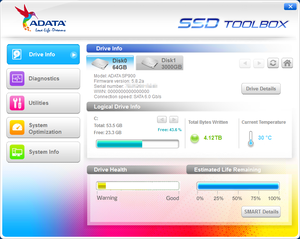Are there other factors besides writes that affect the SSD Life Left SMART flag? I had a sudden surprise last night when I RDP into my Windows 7 Pro machine that I use Media Center for recording TV, Steam Game Streaming to my TV and a few other things. There was a an error saying Windows detected a hard disk problem on my C: drive, which is an SSD. The first thing I did was update and run the SSD's diagnostic to see what was going on. It does show a warning on the drive health, but it shows 100% estimated life remaining. I ran all of the diagnostics and it passes. It only shows the raw SMART data and doesn't flag the problem. It also reports the total bytes written in the drive's life at only 4.12TB. The drive just has Windows and a few programs on it, everything else is written to HDDs.
I also have GSmartControl installed, so I updated it and it shows the SSD Life Left flag as the cause for the SMART warning (current value is 6, threshold is 10), which I thought was odd because the drive's diagnostic says that is fine.
I downloaded and installed SSDLife Pro for a 3rd opinion, and it shows the drive health is at 6% and estimates it will fail in less than a month! If the threshold for the warning should have kicked in when it dropped at or below 10%, either Windows didn't get the message, or it dropped suddenly for some reason.
With so few writes to the SSD, I didn't think it would be failing even though it is old. The system does run 24/7 and only reboots once a month for updates. The SSD utility shows 5 years 8 months of power on time with 191 power cycles and 4.12TB of writes. For comparison, the SSD in my gaming PC has a little over 1.5 years of power on time with almost 1300 power cycles and 20TB written. SSDLife Pro shows its health at 100% and estimates 9 years of life left.
I'm already planning to cut my cable after the summer, so I won't need Media Center for recording TV but I need to keep it for Game Streaming and other uses. With Windows 7's EOL coming in January, was going to go with Linux unless MS offered another opportunity to upgrade to Windows 10 for free, but for now I still need Media Center for recording TV and don't have the time to deal with changing OSes right now.
Right now I see 3 options:
I also have GSmartControl installed, so I updated it and it shows the SSD Life Left flag as the cause for the SMART warning (current value is 6, threshold is 10), which I thought was odd because the drive's diagnostic says that is fine.
I downloaded and installed SSDLife Pro for a 3rd opinion, and it shows the drive health is at 6% and estimates it will fail in less than a month! If the threshold for the warning should have kicked in when it dropped at or below 10%, either Windows didn't get the message, or it dropped suddenly for some reason.
With so few writes to the SSD, I didn't think it would be failing even though it is old. The system does run 24/7 and only reboots once a month for updates. The SSD utility shows 5 years 8 months of power on time with 191 power cycles and 4.12TB of writes. For comparison, the SSD in my gaming PC has a little over 1.5 years of power on time with almost 1300 power cycles and 20TB written. SSDLife Pro shows its health at 100% and estimates 9 years of life left.
I'm already planning to cut my cable after the summer, so I won't need Media Center for recording TV but I need to keep it for Game Streaming and other uses. With Windows 7's EOL coming in January, was going to go with Linux unless MS offered another opportunity to upgrade to Windows 10 for free, but for now I still need Media Center for recording TV and don't have the time to deal with changing OSes right now.
Right now I see 3 options:
- Spend money and save a bit of time by buying a new drive and cloning the failing one.
- Spend time and Install Windows to one of the HDDs already in it and set everything back up.
- Ride it out and hope it doesn't fail until I after the summer when I had planned working on it anyway. Nothing important is installed on it, so I won't lose anything if it fails and I will have to go with option 1 or 2 anyway.
![[H]ard|Forum](/styles/hardforum/xenforo/logo_dark.png)

